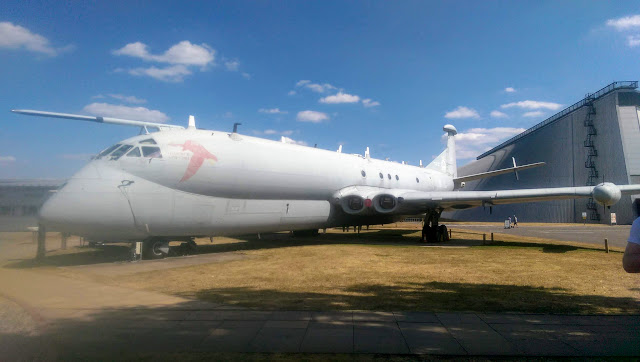 |
| The View from the Gallery from the Cold War Hanger |
Through my job, I have gotten the opportunity to work within the museum at RAF Cosford. At first, I be just shadowing the staff. But hopefully by the end, I will be taking workshops and classes. It's all based on STEM outreach again just in the environment of a museum. And I am so looking forward to getting started. I just love anything to do with machines (Cars, Planes or Ships). But I specifically appreciate planes. Especially aircraft which were linked to the two world wars. My love of planes mostly stems from my history as an air cadet from the age of 15. I was taught the principals of flight as well as most of the iconic planes such as Spitfires, Hurricane, Lancaster Bomber along with the modern airplanes of today. But to be honest, I loved all the lessons at the air cadets which involved science and planes. I reckon if I hadn't didn't go down my current path within STEM or done my university degree, I would have become an engineer. I love machinery and learning how everything works..
Due to the fact that we would be working here shortly, Ryan and I were going through an induction to the museum. This involved meeting with the team who were in charge of education and outreach, sorting out general admin as well as completely a walk of the building. Which is to fundamentally work out where all the fire exits and toilets are. So basically, we had a complete tour of the RAF Cosford museum! Got to say, that tour was amazing! Wish I could do it again tomorrow. It was so cool/interesting just to walk around the whole museum and we didn't just walk around looking for the exits. The man in charge of the induction gave us facts about mostly all of the exhibits.
I've have been to the museum at Cosford once before. All of the pictures featured in the blog come from that visit in July. But today, it was so fun walking around with someone who actually knew the history of the airplanes. It was pretty amazing to here. The man also gave us a special insight into the museum and the stories behind the exhibits.
 |
| This is Nimrod R1 which Ryan and I went in |
 |
| The Sopwith Pup - The only original WW1 plane in the museum |
Another major part of the day was walking around the hanger known as Test fight. It shows all of the prototype planes which I love to see. Along with some of the planes from WWI and WWII. There were plenty of stories about the spitfire and hurricane which sit in the exhibit. But, they weren't the only stories. The museum also have a Japanese section of the museum which contained planes such as the Yokosuka MXY-7 Ohka rocket planes (Known commonly as the Kamikaze planes) and a Kawasaki - the KI-100 was the one on display. There is also one of the largest collection of Axis planes dotted about the exhibit. German planes which I recall were a couple types of Messerschmitt and parts of a Dornier (Which had crashed at sea). But, my favourite story came from the Sopwith Pup. The plane pictured above was of the plane mentioned. And this particular was found in a barn (I believe in France) without the engine, gauges and the wooden props (The wood that hold the 2 fabric wings together). Amazingly, the fabric wings were found without any damage to them. If that wasn't miraculous, the wings also had the registration number on them - meaning they could be tracked. The wings were able to be paired up with the body.
The Sopwith Pup was built in 1916. It was based on the standard biplane wing structure. The first one flew in 22nd December of 1916 and ended up helping/effecting the war effort. It could travel up to the speed of 112 mph which was quite fast for the time. Yet only one person would man the plane.
 |
Two aeroplane from the Japanese Section - The Yokosuka MXY-7 Ohko Rocket Plane and The Kawasaki Ki-100 |
I loved walking around the Museum at Cosford today (If you want to see more pictures of Cosford, there was an instagram post from my visit. Which I've linked at the bottom). Especially enjoyed it when we got the chance to head inside the conservation centre. Normally, it would be only open on special dates of the year when the public get a chance to see the planes which are getting restored. Ryan and I got the opportunity to stand on the gallery of the conservation centre and hear about the construction projects that were going on. I loved this building with planes in different stages of progress on the ground and various pieces of parts shelved away. It really was interesting. I know when we do workshops and educational things, it will be branching into different parts of science. But, I'm quite excited to do both. Can't wait to get started!
The RAF Cosford Museum Photos
For those who might what to know more. Please read My Colleague's Blog
Comments
Post a Comment